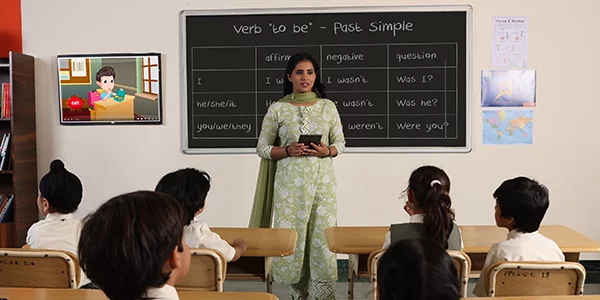Affordable Primary Science Tuition Singapore for All Learning Needs
Affordable Primary Science Tuition Singapore for All Learning Needs
Blog Article
A Comprehensive Overview to the Different Learning Approaches in Main Scientific Research Direction
The exploration of varied discovering techniques in primary scientific research instruction offers an opportunity for instructors to improve student involvement and comprehension significantly. By examining hands-on understanding strategies, inquiry-based techniques, and collaborative methods, we can identify reliable practices that deal with various finding out designs. Additionally, the assimilation of technology and separated instruction plays a crucial function in cultivating a comprehensive atmosphere. The concern continues to be: how can these techniques be properly implemented in the class to maximize their effect? The answer lies in a more detailed analysis of each strategy and its implications for mentor science.

Hands-On Understanding Techniques
Hands-on learning strategies play a pivotal function in main science direction, engaging trainees in active exploration and testing. These techniques allow learners to interact straight with products and sensations, promoting a much deeper understanding of clinical concepts. By making use of manipulatives, designs, and real-life experiments, educators produce an atmosphere where trainees can observe, hypothesize, and test their ideas.
Such strategies not just boost comprehension yet additionally grow important reasoning and analytical skills. When pupils join tasks like developing straightforward equipments, growing seeds, or carrying out chemical reactions, they are encouraged to ask inquiries and seek answers via their very own monitorings. This experiential strategy assists to demystify intricate scientific concepts, making them a lot more relatable and available.
Furthermore, hands-on knowing advertises partnership among peers, as trainees frequently operate in groups to perform experiments or share searchings for. This teamwork not just enhances their learning experience yet also establishes important social abilities. Eventually, integrating hands-on methods in primary scientific research instruction promotes a long-lasting love of knowing and inquisitiveness about the all-natural world, laying a strong structure for future scholastic pursuits in scientific research and past.
Inquiry-Based Knowing
Inquiry-based understanding is an instructional technique that urges trainees to ask concerns, check out phenomena, and build their very own understanding of clinical concepts. This technique changes the focus from typical teacher-led direction to an extra student-centered experience, where students take the initiative in their educational trip. By fostering curiosity, inquiry-based knowing promotes much deeper engagement with the material, enabling trainees to check out subjects in a purposeful context.
In practice, this method usually entails hands-on experiments, monitorings, and critical thinking activities that align closely with the scientific technique. Trainees are motivated to develop theories, style investigations, and examine data, which cultivates crucial abilities such as logical and analytical reasoning. The role of the educator in this framework is to facilitate exploration, directing students via the questions procedure while motivating independent thought and collaboration.
Moreover, inquiry-based learning supports a sense of possession over the understanding procedure, motivating students to seek understanding actively. This approach not just boosts understanding of clinical concepts yet additionally promotes a lifelong love for understanding, furnishing students with the abilities essential to browse a progressively complex globe.
Collaborative Discovering Approaches
Joint knowing techniques equip pupils to engage in meaningful communications with peers, cultivating a common responsibility for their educational results. In main scientific research instruction, these methods urge students to collaborate to explore scientific concepts, resolve issues, and carry out experiments (primary science tuition Singapore). By getting involved in group activities, students can leverage diverse point of views, enabling richer understanding and retention of scientific understanding
One secret element of joint understanding is the focus on interaction skills. Students must articulate their thoughts, pay attention proactively to others, and discuss concepts, every one of which are essential expertises in both real-world and scholastic contexts. This social communication not just enhances their understanding of scientific principles yet likewise promotes team effort and dispute resolution skills.
When pupils see the value of their contributions within a team, they are extra likely to take ownership of their discovering journey. On the whole, incorporating collective learning techniques in key science direction grows a dynamic knowing setting that prepares pupils for future academic and social difficulties.
Modern Technology Combination in Scientific Research
The integration of modern technology in key science direction improves finding out experiences by giving ingenious devices and sources that sustain numerous teaching approaches, including collective discovering - primary science tuition Singapore. Making use of electronic platforms, simulations, and interactive applications permits pupils to involve deeply with clinical principles, helping with a more hands-on method to discovering
Online labs, as an example, enable students to perform experiments securely and successfully, advertising inquiry-based discovering. These devices can replicate real-world scientific click to investigate situations, allowing trainees to envision intricate procedures that would certainly be challenging to duplicate in a conventional classroom setup. In addition, technology fosters communication and cooperation amongst trainees, as they can share findings and collaborate on projects via on-line systems.
In addition, multimedia presentations and educational video clips can enrich lessons by dealing with diverse learning designs, making abstract concepts extra easily accessible. Data analysis tools also encourage students to accumulate and translate clinical data, enhancing important believing abilities. Generally, the strategic unification of technology in main scientific research direction not just enhances interaction however also prepares trainees for a highly advanced culture, outfitting them with vital abilities for future see this page scientific ventures.
Set Apart Instruction Approaches
Distinguished guideline strategies are vital for resolving the diverse needs of learners in main scientific research education and learning. These strategies make it possible for teachers to tailor their mentor approaches to accommodate varying abilities, rate of interests, and discovering designs within the class. By using distinguished guideline, educators can develop a comprehensive setting that fosters engagement and enhances understanding of scientific concepts.
One effective technique is to make use of adaptable organizing, which permits trainees to work together with peers at similar skill levels or with differing viewpoints. This strategy urges peer knowing and promotes crucial thinking. Additionally, supplying selections in tasks can equip students, allowing them to pick jobs that resonate with their rate of interests while still meeting curricular objectives.
Furthermore, integrating tiered tasks is another important strategy. Deliberately tasks with varying degrees of complexity, instructors can make certain that all trainees are appropriately tested, no matter their proficiency. Using formative analyses to assess understanding more allows educators to change their instructional techniques dynamically, guaranteeing that each student obtains the support they require.
Ultimately, applying separated instruction methods in primary science education and learning not only boosts trainee understanding results yet also grows an interest for science, preparing trainees for future scholastic pursuits.

Conclusion
In recap, effective key science direction necessitates a diverse approach that includes hands-on learning, inquiry-based approaches, and joint methods. The integration of modern technology and distinguished direction further satisfies varied learning styles, promoting a setting for exploration and essential thinking. By carrying out these approaches, educators can improve trainee engagement and understanding, inevitably nurturing a lifelong enthusiasm for scientific research and questions. Such extensive methods are essential for developing notified and curious future researchers.
The expedition of diverse knowing approaches in main scientific research direction presents a chance for educators to boost trainee interaction and comprehension significantly.Hands-on knowing strategies play an essential function in primary scientific research instruction, involving pupils in energetic expedition and experimentation.Inquiry-based understanding is an educational strategy that motivates students to ask concerns, examine sensations, and you could try this out build their very own understanding of clinical principles.Joint understanding strategies encourage students to engage in purposeful interactions with peers, cultivating a shared duty for their instructional results. Overall, incorporating joint understanding techniques in primary science instruction grows a dynamic understanding environment that prepares pupils for future academic and social difficulties.
Report this page